
F-Roads in Iceland: A Guide to Icelandic Mountain Roads

- Where to Find the F-Roads of Iceland
- When Are the F-Roads Open?
- What Type of Car is Suitable for F-Roads?
- River Crossings on F-Roads
- Notable F-Roads in Iceland
- F26 - Sprengisandur
- F35 - Kjolur
- F249 - Thorsmork
- F88 - Askja
- F225 - Landmannalaugar
- Super Jeep Tours on the F-Roads of Iceland
- FAQs about F-Roads in Iceland
- What are F-roads in Iceland?
- Can I drive on F-roads with a regular rental car?
- Are the F-roads open in winter?
- Is off-road driving allowed in Iceland?
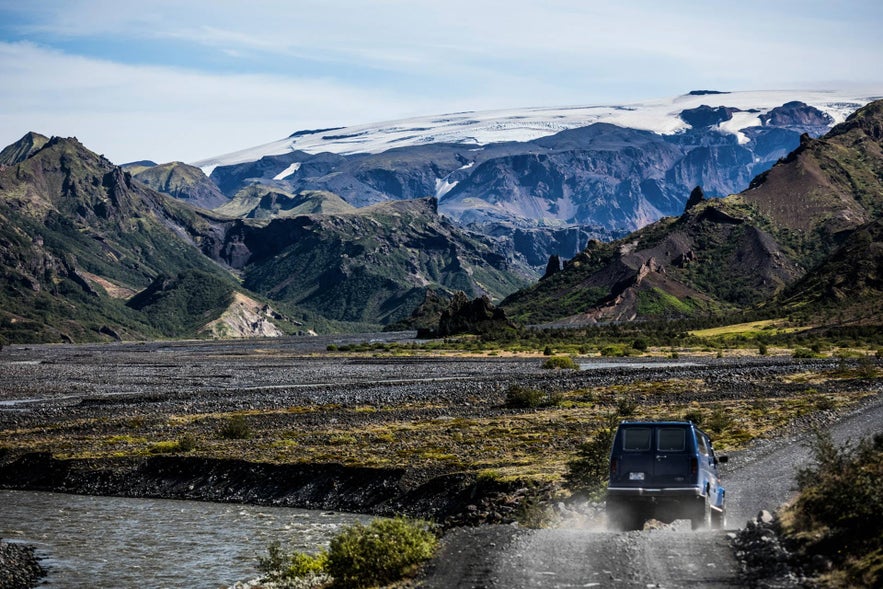
The most flexible way to explore Iceland and all of its wonders is to rent a car. Having your own vehicle allows you to set your own pace, choose your route, and make unplanned stops if something catches your eye.
If you want a bit more structure to your adventure, going on a self-drive tour is another great way of exploring Iceland by car. While the Icelandic road system is excellent, you will need to make certain preparations if you're planning on visiting some of the more remote sights.
F-roads in Iceland refer to "mountain roads" (the "F" referring to the Icelandic word for mountain: "Fjall") that are primarily found in the Highlands and less accessible parts of the country. Usually only open during the summer months, F-roads can be tricky to traverse and require renting a 4x4 vehicle ready to take them on.
The Icelandic wilderness is chock full of natural wonders just begging to be explored. If you're planning on visiting spectacular locations found at the end of these bumpy roads, you're going to need to be prepared. Now, let's get into everything you need to know about F-roads in Iceland!
Where to Find the F-Roads of Iceland
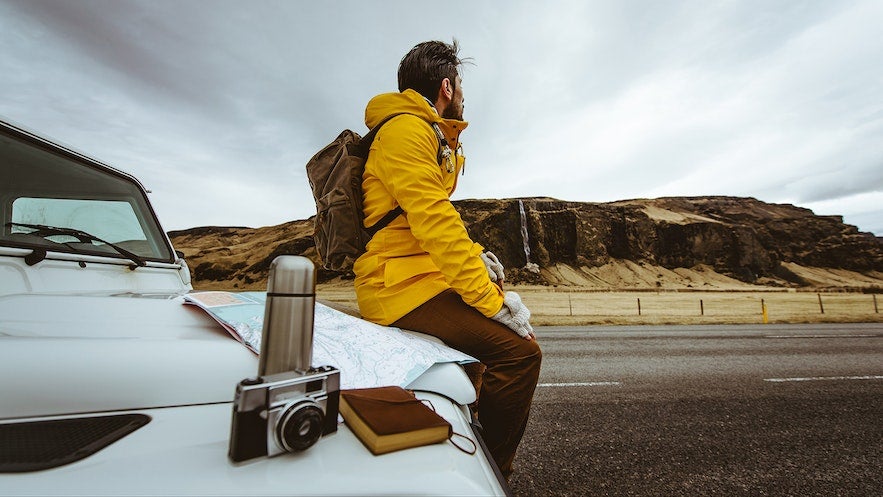 Iceland's main road is called the Ring Road, or Route 1. This road encircles all of Iceland, allowing visitors to see all of the country's regions, bar the Westfjords and the Highlands. As the Ring Road is paved and well-maintained, you can traverse all of it using a regular car, but some of Iceland's F-roads connect directly to the Ring Road.
Iceland's main road is called the Ring Road, or Route 1. This road encircles all of Iceland, allowing visitors to see all of the country's regions, bar the Westfjords and the Highlands. As the Ring Road is paved and well-maintained, you can traverse all of it using a regular car, but some of Iceland's F-roads connect directly to the Ring Road.
Identifying an F-road in Iceland is relatively straightforward, as F-roads are clearly marked with an "F" before their number. For example, F35 is an F-road, whereas Route 1 (the Ring Road) is not.
F-roads are often narrower, less maintained, and more rugged than primary roads. They are usually gravel roads, though some can be rougher tracks, especially as you go deeper into the Highlands.
- Read more: How to Drive Safely in Iceland
When Are the F-Roads Open?
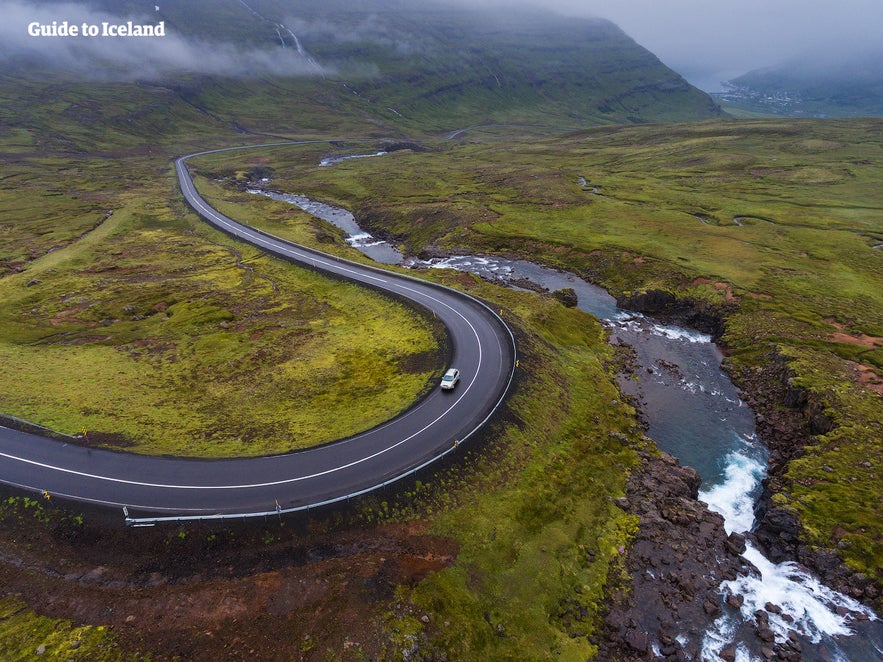
F-roads are only open during the summer months, usually from June to September, depending on weather conditions and snow melting. During other times of the year, these roads are often closed due to unsafe conditions, such as snow, ice, or flooding.
Even during the summer months, you should always check this official website, which lists the conditions of the roads in Iceland at any given time. Even though summer has technically arrived, the roads may still be closed due to unforeseen circumstances.
What Type of Car is Suitable for F-Roads?
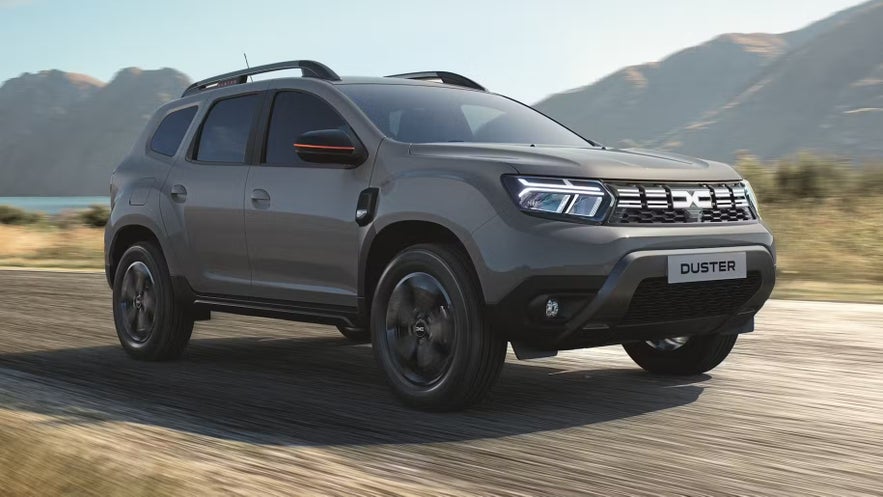 While a 4x4 (four-wheel drive) vehicle is a requirement for driving on F-roads in Iceland, not all 4x4 vehicles are suitable for this purpose. The suitability of a 4x4 vehicle for F-roads depends on several factors, such as ground clearance, tire size, engine power, and river crossing capability.
While a 4x4 (four-wheel drive) vehicle is a requirement for driving on F-roads in Iceland, not all 4x4 vehicles are suitable for this purpose. The suitability of a 4x4 vehicle for F-roads depends on several factors, such as ground clearance, tire size, engine power, and river crossing capability.
This may seem rather complicated, but luckily, our 4x4 rental page specifies which 4x4 cars have highland capabilities. If you plan on driving the F-roads while visiting Iceland, make sure to choose a vehicle with highland capability.
River Crossings on F-Roads
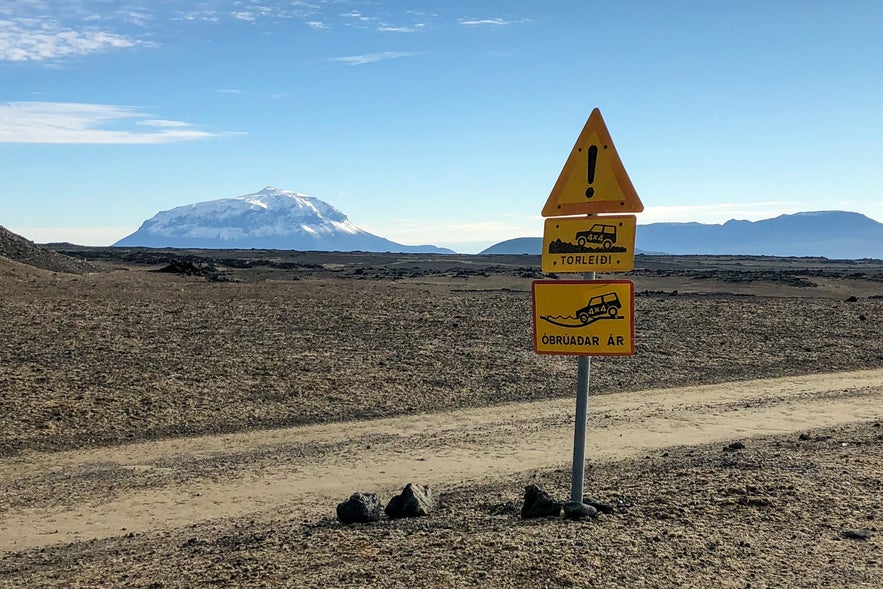 Some F-roads have river crossings, which can be one of the more challenging aspects of driving in the Icelandic wilderness and require careful preparation and caution. There are some essential points to consider when dealing with river crossings.
Some F-roads have river crossings, which can be one of the more challenging aspects of driving in the Icelandic wilderness and require careful preparation and caution. There are some essential points to consider when dealing with river crossings.
Check Road and Weather Conditions: Before setting off, check the current road and weather conditions. Conditions in Iceland can change rapidly, and what might be a small stream in the morning could turn into a dangerous river by the afternoon due to rain or glacial melt. Most rivers have a lower flow in the early morning.
Suitable Vehicle: Use a 4x4 vehicle that's designed for rough terrain and river crossings. The vehicle should have adequate ground clearance and be in good mechanical condition. Standard rental cars are not suitable for river crossings.
 Cross at Designated Points: Cross rivers at designated crossing points, where the river is likely to be at its shallowest and most stable. If you do not see a designated crossing point, the rule of thumb is that the river is the deepest where the waters are the calmest.
Cross at Designated Points: Cross rivers at designated crossing points, where the river is likely to be at its shallowest and most stable. If you do not see a designated crossing point, the rule of thumb is that the river is the deepest where the waters are the calmest.
Avoid Crossing Rivers Alone: Try not to cross rivers alone. Having another vehicle with you can be invaluable if you encounter difficulties.
If you intend to make river crossings during your travels, make sure to check your rental car's insurance policy. No Icelandic car rental covers insurance for crossing rivers, so be very careful.
Notable F-Roads in Iceland
Now that we've got the basics down let's go over some of the most traveled F-roads in Iceland.
F26 - Sprengisandur
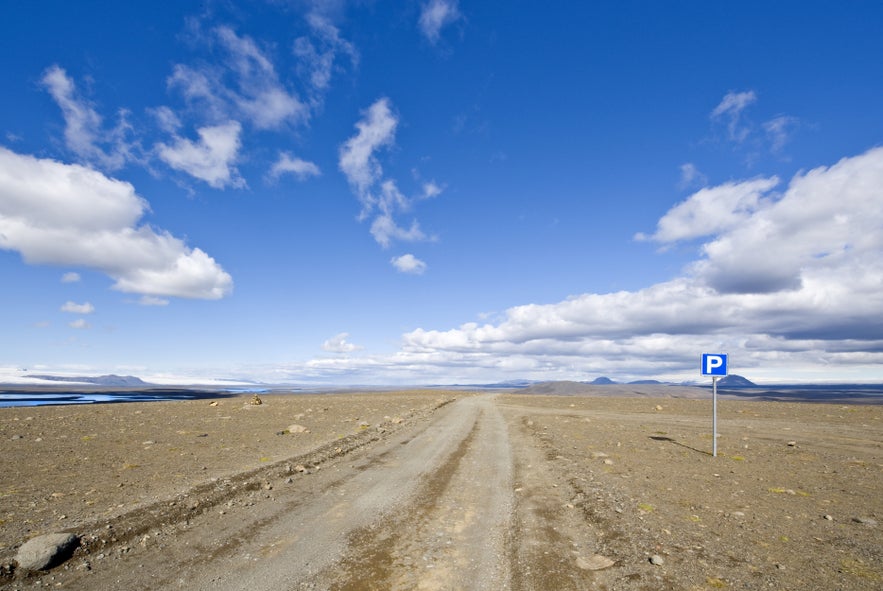
Route F26, commonly known as the Sprengisandur Route, or "Sprengisandsleið" in Icelandic, is one of the longest F-roads in Iceland at approximately 200 kilometers. It connects the southern part of Iceland near the Hofsjokull glacier to the northern region near Lake Myvatn.
The journey along F26 is known for its stark and dramatic landscapes. The route passes through a desolate area of black sand deserts, volcanic fields, and rugged mountain scenery. The absence of vegetation in many parts of Sprengisandur gives it a moon-like appearance, offering a sense of isolation and wilderness.
The harsh landscape of Sprengisandur is steeped in folklore as the area pops up in several sagas and traditional Icelandic songs, with outlaws and all kinds of creatures hiding in the dark sands. There is a river crossing in F26 that drivers need to be equipped to deal with.
There are no services along the F26, so travelers must be well-prepared with sufficient fuel, food, water, and emergency supplies. The route is also devoid of any formal accommodations, making it a popular choice for those interested in camping and experiencing Iceland's raw nature.
F35 - Kjolur
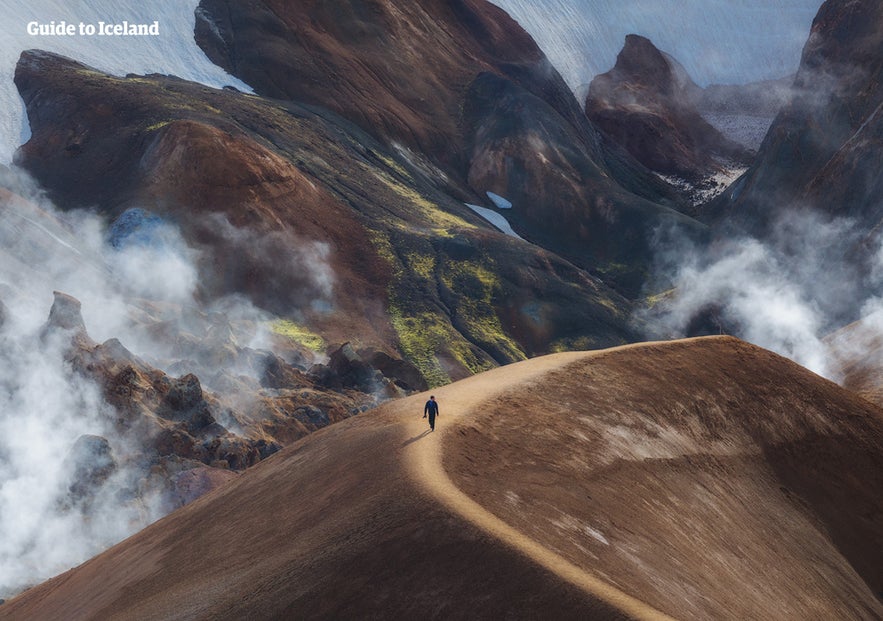 The F35 Kjolur route, also known in Icelandic as "Kjalvegur," is one of the two main highland tracks cutting through the interior of Iceland, running from Gullfoss in the south to Blonduos in the north, effectively bridging the gap between southern and northern regions of Iceland.
The F35 Kjolur route, also known in Icelandic as "Kjalvegur," is one of the two main highland tracks cutting through the interior of Iceland, running from Gullfoss in the south to Blonduos in the north, effectively bridging the gap between southern and northern regions of Iceland.
Due to recent road improvements, it is actually no longer officially classified as an F-road but is still often referred to as one. It is less challenging than some other highland routes, like the F26, making it more accessible to a wider range of travelers with appropriate 4x4 vehicles.
One of the highlights along F35 is Hveravellir, a geothermal area located roughly halfway along the route, and the Kerlingarfjoll mountain range, which is renowned for its beautifully colored rhyolite peaks and large geothermal area.
Overall, the F35 offers a more approachable adventure into Iceland's highlands compared to more rugged routes. Its mix of accessible yet remote landscapes, coupled with historical and geological significance.
F249 - Thorsmork
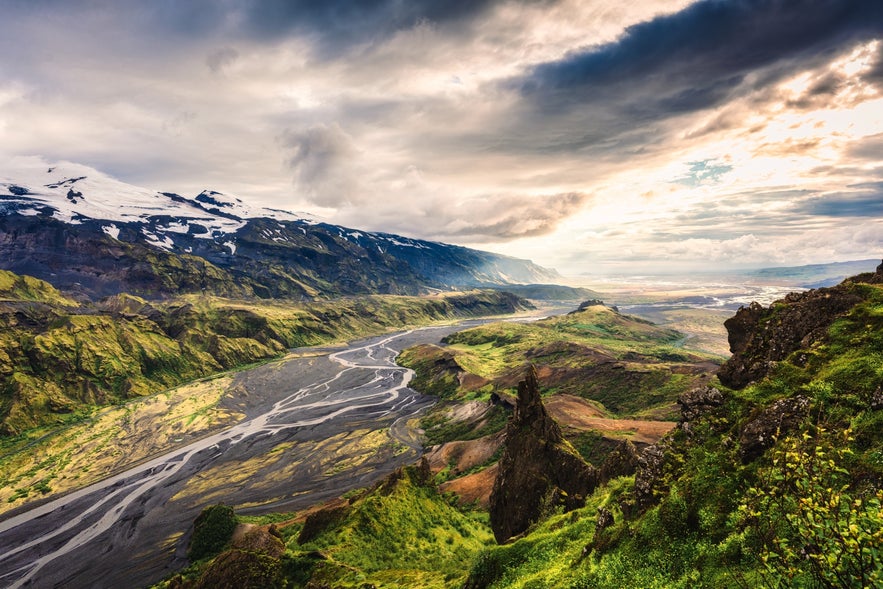
Route F249 leads to the Thorsmork Nature Reserve, a stunning valley surrounded by glaciers and rugged mountains located in the southern part of Iceland. This route diverges straight from the main Ring Road (Route 1) and involves multiple river crossings.
The initial river crossings on the way to Thorsmork are not too daunting until you get to the river Krossa. This river crossing is perhaps the most infamous and dangerous in Iceland and has claimed many rental cars in the past. It should not be crossed by anyone except the most experienced drivers.
This is why we advise against crossing the river yourself and instead take a guided tour, such as this super Jeep and hiking tour of Thorsmork. Leaving the river crossing to the experts is the best way to enjoy the spectacular sights in Thorsmork without worrying about your rental car becoming another victim of the river Krossa.
The journey on F249 offers a diverse array of landscapes, including glacial rivers, lush valleys, and dramatic mountain scenery. The road is known for its challenging conditions, particularly the river crossings, which can be daunting and vary significantly in depth, especially after heavy rains or glacial melt. These crossings require careful judgment and experience in fording rivers.
F88 - Askja
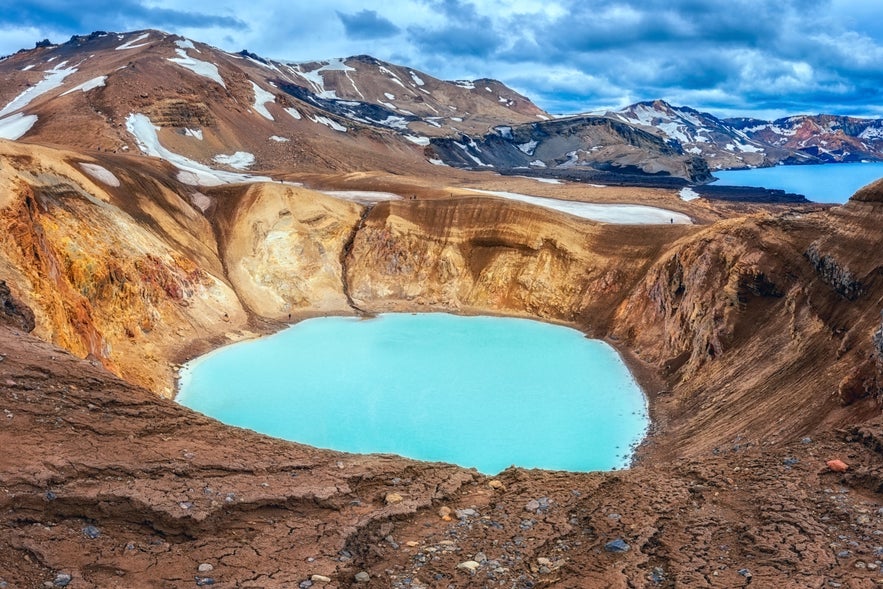
Askja is a caldera in the central Highlands of Iceland that was the site of a terrifying eruption in the 19th century. Today, the area is absolutely stunning and well worth the visit, although people often disagree about the best way to get there.
As F88 is called "Askja Route," or "Oskjuleid" in Icelandic, it stands to reason that it would be the best way to get there. However, there are several river crossings, with the final one over the river Linda being perilous if water levels are high.
This is why we do not recommend taking the F88 at all but rather following our guide on how to visit Askja and taking other F-roads instead. It might seem more complicated, but having to turn back or get into trouble because of high water levels on the F88 is surely worse.
Once at Askja, you can take in the stunning scenery. Locations are sometimes described as otherworldly, but we think it's quite an apt description as NASA astronauts actually used these lunar landscapes as training grounds for the Apollo missions!
F225 - Landmannalaugar
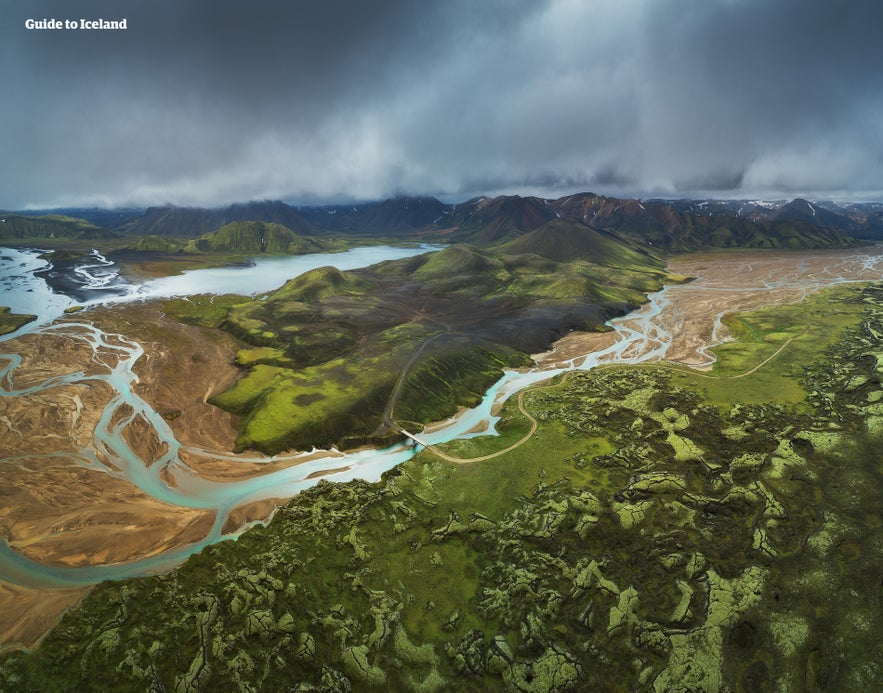 Route F225, called "Landmannaleið" in Icelandic, is a route that lies to the Landmannalaugar area, which is full of colorful rhyolite mountains and geothermal hot springs. Throughout the summer, it is one of the most popular places in Iceland for hiking and natural hot spring bathing.
Route F225, called "Landmannaleið" in Icelandic, is a route that lies to the Landmannalaugar area, which is full of colorful rhyolite mountains and geothermal hot springs. Throughout the summer, it is one of the most popular places in Iceland for hiking and natural hot spring bathing.
Drivers on F225 should be prepared for river crossings that are easily crossed on a 4x4 under normal circumstances but can be challenging, especially after periods of heavy rain or during glacial melt. The river crossings are quite tame compared to ones found in many other F-roads, so you shouldn't be too off-put if you're driving a decent 4x4.
If you want to visit Landmannalaugar but would like to avoid river crossings, you can also take the F208, which has actually been recently reclassified as simply 208 due to road improvements. This road is a bit longer than the F225 but considerably less hassle.
Once you get to Landmannalaugar, you'll be greeted by stunning scenery that features numerous hiking trails, ranging from short walks to multi-day treks like the famous Laugavegur trail. Don't forget to take a dip in the hot springs by the newly constructed bathing facilities.
Super Jeep Tours on the F-Roads of Iceland
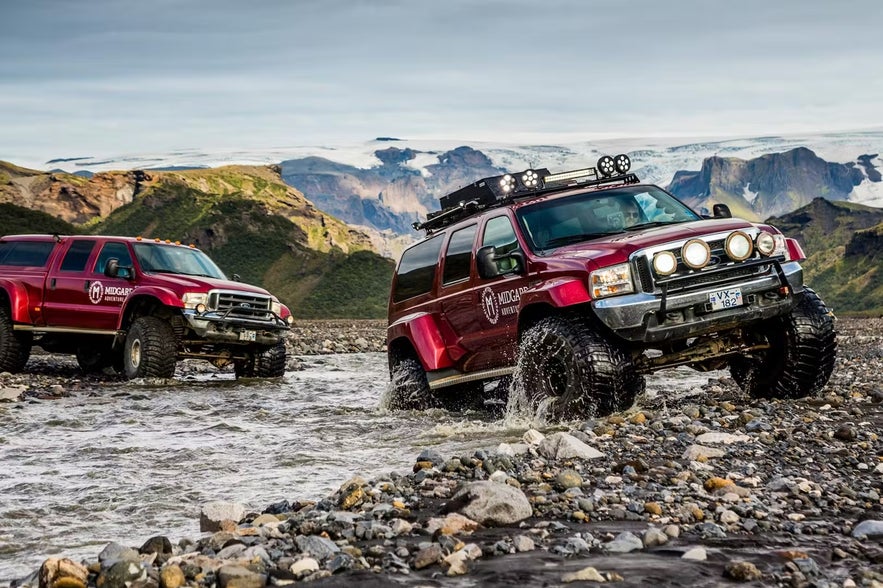
Photo from Scenic 7-Hour Super Jeep Tour in Thorsmork Valley with Transfer from Hvolsvollur.
If you don't plan on taking on the F-roads of Iceland by yourself but would still like to experience taking on the more rugged side of Iceland's nature, there are many great highland tours available where you can leave the driving to the experts.
Take, for example, this Landmannalaugar super jeep tour, where you are picked up in the city by a large and luxurious vehicle built to take on the rugged roads. This will allow you to take in natural wonders such as waterfalls, lakes, and gorgeous scenery in Landmannalaugar while getting expert guidance.
There is also a super jeep tour of Askja available, where you can travel to the caldera and the nearby lava field of Holuhraun to take in the otherworldly landscapes. During late summer, you might even get the opportunity to go swimming in the Viti explosion crater, one of the most unusual bathing experiences around.
Another great option is this 7-hour super jeep tour of Thorsmork, where you get to explore the nature reserve without having to worry about crossing the Krossa river. As there is so much to do and see in Thorsmork, it's easy to become overwhelmed, but here, you will have local expertise to help guide you to the best bits.
FAQs about F-Roads in Iceland
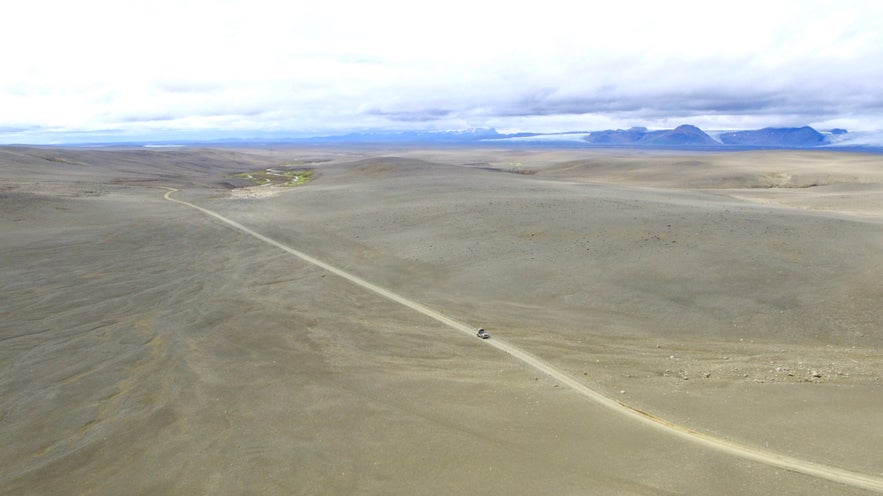 Here are the answers to some of the most frequently asked questions about F-roads in Iceland.
Here are the answers to some of the most frequently asked questions about F-roads in Iceland.
What are F-roads in Iceland?
F-roads are mountain roads in Iceland's highlands. They are unpaved tracks that can be rough and challenging, offering access to some of the country's most remote and stunning landscapes.
Can I drive on F-roads with a regular rental car?
No, regular rental cars are not suitable for F-roads. You need to rent a suitable 4x4 vehicle specifically allowed by the rental company for F-road travel, as these roads often have rough terrain, steep inclines, and river crossings.
Are the F-roads open in winter?
No, F-roads are typically open during the summer months, from June to September. However, opening times vary based on weather conditions and snow melting, so always check current road conditions.
Is off-road driving allowed in Iceland?
No, off-road driving is strictly prohibited in Iceland to protect the delicate natural environment. You must stay on marked roads and tracks.
That's it for F-road driving in Iceland for now. Do you have any experience with driving in the Icelandic Highlands? Did we leave any questions unanswered? Let us know in the comments!
더 많은 흥미로운 게시글
아이슬란드의 겨울 베스트 액티비티
아이슬란드의 겨울에 즐길 수 있는 일들은 뭐가 있을까요? 아이슬란드의 겨울은 언제일까요? 어떤 액티비티들이 있을까요? 어떤 겨울 투어가 있을까요? 이런 모든 질문에 답해드리겠습니다. 아이슬란드의 겨울은 조금 춥긴 하지만 오로라(Northern light: 북극광)를 볼 수 있는 걸로 유명합니다. 그만큼 북쪽이라서 추울거라 예상되지만, 그렇게 춥진 않습니다...더 보기아이슬란드 현지인이 당연하게 누리는 놀라운 10가지
오직 아이슬란드에서만 찾을 수 있는 놀라운 점 들에는 어떤 것들이 있을까요? 아이슬란드 사람들이 아이슬란드에서 특별하게 누리는 점 들에는 무엇이 있을까요? 이런 특별한 점들은 참 많이 있습니다. 자연, 삶의 질, 오로라, 언어, 음식 등등 아이슬란드 사람들은 다양한 이유로 자신들의 조국을 자랑스러워 합니다. 하지만 이번에는 이 사람들이 당연히 생각하고...더 보기아이슬란드에 가야 할 15가지 이유
관광객들이 아이슬란드에 가는 이유는 무엇일까요. 아이슬란드를 방문하고 싶게 만드는 최고의 명소는 어디인지 궁금해집니다. 다음 휴가지를 결정하고 싶다면, 아이슬란드를 방문해야 하는 15가지 이유를 읽어보시기 바랍니다. 아이슬란드 최고의 명소 18곳 | 꼭 해봐야 할 일과 가봐야 할 곳을 소개합니다. 레이캬비크에서 꼭 해야 할 일...더 보기

아이슬란드 최대의 여행 마켓플레이스를 전화에 다운로드하여 전체 여행을 한 곳에서 관리하세요
전화 카메라로 이 QR 코드를 스캔하고 표시되는 링크를 누르면 아이슬란드 최대의 여행 마켓플레이스를 주머니에 넣을 수 있답니다. 다운로드 링크가 포함된 SMS 또는 이메일을 받으려면 전화번호 또는 이메일 주소를 추가하세요.




















